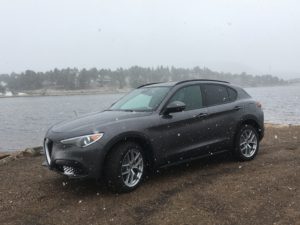
I’ll sprint to great lengths (or heights) in revealing to my readers the workings of a new automotive model.
Stelvio Pass in the Alps of northern Italy reaches 9,045 feet above sea level; move the zero two digits to the right and 9,450 is the altitude for Bear Lake in the Rocky Mountain National Park in northern Colorado.
With elevation numbers tied so tightly, Bear Lake, of course, was an ideal destination for the new 2018 Alfa Romeo Stelvio SUV, and I drove it there in a light snow on a cold day in late October.
The climbs and twists of the narrow road to Bear Lake are a decent challenge for the great-handling Stelvio, namesake of the Italian mountain pass.
The 2018 Alfa Romeo Stelvio Ti Sport, with Q4 all-wheel drive, is based on Alfa’s Giulia luxury sport sedan, which I reviewed in July. They’re built at Cassino, a Fiat Chrysler Automobile Group plant in the province of Frosinone, Italy.
Stelvio is the newest midsize SUV on the U.S. market, on a wheelbase of 111 inches, curb weight of 4,050 pounds and suspension of double wishbone with semivirtual steering axle in front and all-aluminum rear with a vertical rod across.
Introduction of the Alfa Romeo entry followed by a number of months that of the Jaguar F-Pace. The Alfa is a couple inches shorter than the Jag and its cargo space is much smaller; the Stelvio, though, holds its own in high-country performance against the Jaguar, as well as other competitors Audi Q5, Mercedes-Benz GLC, BMW X3, Volvo XC60, Infiniti QX50 or Land Rover Discovery Sport.
Like most of the others, the Stelvio is driven by a 2.0-liter, turbocharged 4-cylinder engine and 8-speed automatic transmission with manual mode. It develops 280 horsepower and 306 lb.-ft. of torque, with plenty of kick to go with its handling and cornering capabilities.
Its drive-mode selector system, instead of the ususal eco/comfort/sport choices, lists them as Advanced Efficiency/Natural/Dynamic. As the driver selects one or the other, the system customizes the shift timing, steering feel and braking response. The driver gets even more involved with paddle shifters, tied to the steering column and long enough (6.5 inches) to hinder quick touches of side stalks.
The Stelvio’s low-end acceleration and cornering highlighted the run up to Bear Lake. The descent on the return drive was a paradise of wildlife viewing, including a stop in the road to give 11 wild turkeys an uninterrupted crossing at a slow pace. Farther down, we joined other cars parked along a side road to see more than 100 elk in a meadow in the Hollowell Park area. Numerous deer were along the way, too.
The earlier highway drive to Denver, Boulder, Lyons and up into the park lifted fuel mileage to 25.5. The Alfa’s EPA estimate is 22/28.
An interior slight, in addition to the cramped cargo area, is the unusually small screen for rearview camera and navigation. Good sound emanates from a Harmon Kardon premium system with 14 speakers. Front seats are narrowly bolstered; the overall chocolate interior is accented by a dual-pane sunroof. Rear seats are short on legroom.
Brake discs are 13 inches in front and 12.5 at the rear; visible through the Y-spoked wheels are red Brembo brake calipers. We got an appreciative demonstration of the Alfa Romeo autonomous emergency braking system on 47th Avenue in Greeley, when brakes on the car ahead of us were slammed when cut off by another; I would have stopped the Alfa before it hit the car ahead, but not quite as instantly as did the autonomous emergency brakes.
Sticker price on the Alfa Romeo Stelvio was $53,640, slightly lower than most of the competitive luxury makes.